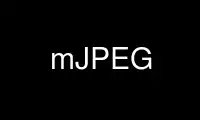
This is the command mJPEG that can be run in the OnWorks free hosting provider using one of our multiple free online workstations such as Ubuntu Online, Fedora Online, Windows online emulator or MAC OS online emulator
PROGRAM:
NAME
mJPEG - Convert FITS images or mosaics into grayscale or color JPEG images
SYNOPSIS
mJPEG [-d] [-t power] [-s statusfile] [-ct color-table]
[-gray in.fits minrange maxrange [logpower/gaussian]
[-red red.fits rminrange rmaxrange [rlogpower/gaussian]
[-green green.fits gminrange gmaxrange [glogpower/gaussian]
[-blue blue.fits bminrange bmaxrange [blogpower/gaussian]
-out out.jpg
DESCRIPTION
Generates a JPEG image file from a FITS file (or a set of three FITS files in color). A
data range for each image can be defined, and the data can be stretched by any power of
the log() function (including zero: linear). Pseudo-color color tables can be applied in
single-image mode.
Note: If creating a true color image, all input images must have identical WCS information
(ie, same size, resolution, coordinate system, etc).
OPTIONS
-d Print out additional debugging information
-t power
Increasing the value of power will enhance the contrast between colors; useful when
all pixels are close to white, but you wish to accentuate the color difference.
-s statusfile
Write output and errors to statusfile instead of stdout
-ct color-table
Choose a color table for pseudo-color images; color-table can be an integer between
0 and 11. Click here for samples of each color table.
ARGUMENTS
mJPEG takes as arguments a list of FITS images to be used as input for the true- or
pseudo-color image. To create a pseudo-color image from a single FITS file, use the -gray
flag; to create a true-color image, use the -red, -green, and -blue flags together. The
syntax for each is the same:
-color Provide the image name and stretch information to be used for color (one of:
"gray", "red", "green", "blue")
color.fits
Filename of input image for this color. Can use a specific FITS extension by
including it as: "filename.fits[X]", where X is the HDU number.
minrange maxrange
Lower/upper pixel values to use when stretching the image. Can also be expressed
as a percentage, a sigma value, or any combination of these three. Some examples:
0 100
0s 99.999%
-1s 1s
logpower/gaussian
Specify a log power to use in stretching the image. Can be a positive integer or
one of:
log
loglog
linear (default)
-out out.jpg
Path to the output JPEG image
RESULT
The output message includes stretch information from the creation of the JPEG:
Psuedo-color (gray input only):
[struct stat="OK", min=datamin, minpercent=minfrac, max=datamax, maxpercent=maxfrac]
Three-color (red/green/blue inputs):
[struct stat="OK", bmin=bdatamin, bminpercent=bminfrac, bmax=bdatamax,
bmaxpercent=bmaxfrac, gmin=gdatamin, gminpercent=gminfrac, gmax=gdatamax,
gmaxpercent=gmaxfrac, rmin=rdatamin, rminpercent=rminfrac, rmax=rdatamax,
rmaxpercent=rmaxfrac]
EXAMPLES
To create a grayscale image from a FITS file:
$ mJPEG -ct 1 -gray SINGS_B.fits 0s 99.999% gaussian -out SINGS_B.jpg
[struct stat="OK", min=0.391706, minpercent=50.00, max=136.555, maxpercent=100.00]
Output grayscale JPEG:
To create a true 3-color image from three input images:
$ mJPEG -t 2 -blue SINGS_B.fits 0s 99.999% gaussian
-green SINGS_R.fits 0s 99.999% gaussian
-red SINGS_I.fits 0s 99.999% gaussian
-out SINGS_3color.jpg [struct stat="OK", bmin=0.391706, bminpercent=50.00,
bmax=136.555, bmaxpercent=100.00, gmin=2.98851, gminpercent=50.00, gmax=366.148,
gmaxpercent=100.00, rmin=4.26902, rminpercent=50.00, rmax=295.179,
rmaxpercent=100.00]
Use mJPEG online using onworks.net services
